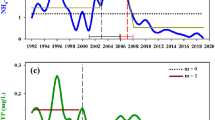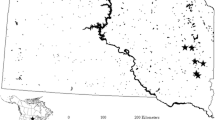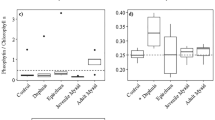Abstract
Human-induced changes in external nutrient loading affect the phytoplankton community and abundance directly by changing the amount of nutrients available, but also indirectly through changes in the zooplankton (that is, grazer) community structure, mediated in part by changes in the fish community structure and biomass. Such shifts affect the species dynamics and community succession of lake phytoplankton communities, and they may ultimately influence community stability. However, the relative importance of different biotic mechanisms influencing the community stability of phytoplankton along nutrient and associated zooplankton grazing pressure gradients remains unclear. Here, we evaluated the importance of four potential stabilizing biotic metrics—taxon richness, synchrony, community dominance and biomass of phytoplankton to the seasonal stability over two decades of re-oligotrophication in 20 Danish lakes. We found no clear temporal patterns in seasonal stability across lakes but considerable variations in the individual lakes. Total phosphorus (TP) affected the seasonal stability of the phytoplankton communities either directly or indirectly through changes in community dominance. Total nitrogen (TN) influenced the seasonal stability indirectly via changes in phytoplankton taxon richness, synchrony, and community dominance. Grazer richness (that is, zooplankton taxa richness) impacted the seasonal stability indirectly through changes in phytoplankton taxon richness and synchrony. Grazing pressure, using the biomass ratio of zooplankton:phytoplankton as a proxy, had an indirect effect on seasonal stability via changes in synchrony and community dominance. Compensatory dynamics (as indicated by the synchrony of phytoplankton) exerted dominant control of phytoplankton seasonal stability at high TN and high grazer richness and pressure, while the portfolio effect (as indicated by taxon richness) contributed to phytoplankton seasonal stability at low TN and high grazer richness. However, a strongly negative selection effect (as indicated by community dominance of phytoplankton) was observed at high nutrient levels and low grazer richness. Grazer richness and grazing pressure had stronger stabilizing effects on the seasonal succession of the phytoplankton communities than did TP and TN. Our results highlight how various biotic mechanisms (for example, compensatory dynamics and portfolio effect) can change in their importance in maintaining the seasonal stability of phytoplankton communities subjected to nutrient and grazer control.





Similar content being viewed by others
Data Availability
Data are from the national survey program and can be obtained from https://danmarksmiljoeportal.zendesk.com/hc/da.
References
Anderson TL, Sheppard LW, Walter JA, Hendricks SP, Levine TD, White DS, Reuman DC. 2019. The dependence of synchrony on timescale and geography in freshwater plankton. Limnol Oceanogr 64:483–502.
Anneville O, Souissi S, Gammeter S, Straile D. 2004. Seasonal and inter-annual scales of variability in phytoplankton assemblages: comparison of phytoplankton dynamics in three peri-alpine lakes over a period of 28 years. Freshw Biol 49:98–115.
Anneville O, Gammeter S, Straile D. 2005. Phosphorus decrease and climate variability: mediators of synchrony in phytoplankton changes among European peri-alpine lakes. Freshw Biol 50:1731–46.
Anneville O, Dur G, Rimet F, Souissi S. 2018. Plasticity in phytoplankton annual periodicity: an adaptation to long-term environmental changes. Hydrobiologia 824:121–41.
Anneville O, Chang CW, Dur G, Souissi S, Rimet F, Hsieh CH. 2019. The paradox of re-oligotrophication: the role of bottom–up versus top–down controls on the phytoplankton community. Oikos 128:1666–77.
Baert JM, De Laender F, Sabbe K, Janssen CR. 2016. Biodiversity increases functional and compositional resistance, but decreases resilience in phytoplankton communities. Ecology 97:3433–40.
Carey CC, Brown BL, Cottingham KL. 2017. The cyanobacterium Gloeotrichia echinulata increases the stability and network complexity of phytoplankton communities. Ecosphere 8:e01830.
Core RD. 2013. R: A language and environment for statistical computing team RDC Vienna, Austria 2006, ISBN 3900051-07-0. http://www.R-project.org.
Cottingham KL, Schindler DE. 2000. Effects of grazer community structure on phytoplankton response to nutrient pulses. Ecology 81:183–200.
Cottingham KL, Glaholt S, Brown AC. 2004. Zooplankton community structure affects how phytoplankton respond to nutrient pulses. Ecology 85:158–71.
Doak DF, Bigger D, Harding E, Marvier M, O’malley R, Thomson D. 1998. The statistical inevitability of stability-diversity relationships in community ecology. Am Nat 151:264–76.
Donohue I, Hillebrand H, Montoya JM, Petchey OL, Pimm SL, Fowler MS, Healy K, Jackson AL, Lurgi M, McClean D. 2016. Navigating the complexity of ecological stability. Ecol Lett 19:1172–85.
Emily G, Lau JA, Schoolmaster DR, Gross KL. 2010. Mechanisms contributing to stability in ecosystem function depend on the environmental context. Ecol Lett 13:1400–10.
Feuchtmayr H, Moran R, Hatton K, Connor L, Heyes T, Moss B, Harvey I, Atkinson D. 2009. Global warming and eutrophication: effects on water chemistry and autotrophic communities in experimental hypertrophic shallow lake mesocosms. J Appl Ecol 46:713–23.
Gallego I, Davidson TA, Jeppesen E, Pérez-Martínez C, Sánchez-Castillo P, Juan M, Fuentes-Rodríguez F, León D, Penalver P, Toj J, Casas JJ. 2012. Taxonomic or ecological approaches? Searching for phytoplankton surrogates in the determination of richness and assemblage composition in ponds. Ecol Ind 18:575–85.
Grace JB, Bollen KA. 2005. Interpreting the results from multiple regression and structural equation models. B Ecol Soc Am 86:283–95.
Hallett LM, Hsu JS, Cleland EE, Collins SL, Dickson TL, Farrer EC, Gherardi LA, Gross KL, Hobbs RJ, Turnbull L. 2014. Biotic mechanisms of community stability shift along a precipitation gradient. Ecology 95:1693–700.
Harper D. 2012. Eutrophication of freshwaters: principles, problems and restoration. Berlin: Springer.
Hautier Y, Tilman D, Isbell F, Seabloom EW, Borer ET, Reich PB. 2015. Anthropogenic environmental changes affect ecosystem stability via biodiversity. Science 348:336–40.
Hector A, Hautier Y, Saner P, Wacker L, Bagchi R, Joshi J, Scherer-Lorenzen M, Spehn EM, Bazeley-White E, Weilenmann M. 2010. General stabilizing effects of plant diversity on grassland productivity through population asynchrony and overyielding. Ecology 91:2213–20.
Hillebrand H, Bennett DM, Cadotte MW. 2008. Consequences of dominance: a review of evenness effects on local and regional ecosystem processes. Ecology 89:1510–20.
Hooper DU, Chapin FS, Ewel J, Hector A, Inchausti P, Lavorel S, Lawton JH, Lodge D, Loreau M, Naeem S. 2005. Effects of biodiversity on ecosystem functioning: a consensus of current knowledge. Ecol Monogr 75:3–35.
Huber V, Gaedke U. 2006. The role of predation for seasonal variability patterns among phytoplankton and ciliates. Oikos 114:265–76.
Jacquet S, Kerimoglu O, Rimet F, Paolini G, Anneville O. 2014. Cyanobacterial bloom termination: the disappearance of Planktothrix rubescens from Lake Bourget (France) after restoration. Freshw Biol 59:2472–87.
Jeppesen E, Jensen JP, Søndergaard M, Lauridsen T, Pedersen LJ, Jensen L. 1997. Top-down control in freshwater lakes: the role of nutrient state, submerged macrophytes and water depth, Shallow Lakes’ 95. Berlin: Springer. pp 151–64.
Jeppesen E, Jensen JP, Søndergaard M. 2002. Response of phytoplankton, zooplankton, and fish to re-oligotrophication: an 11 year study of 23 Danish lakes. Aquat Ecosyst Health Manag 5:31–43.
Jeppesen E, Søndergaard M, Jensen JP, Havens KE, Anneville O, Carvalho L, Coveney MF, Deneke R, Dokulil MT, Foy B. 2005. Lake responses to reduced nutrient loading–an analysis of contemporary long-term data from 35 case studies. Freshw Biol 50:1747–71.
Jeppesen E, Nõges P, Davidson TA, Haberman J, Nõges T, Blank K, Lauridsen LL, Søndergaard M, Sayer C, Laugaste R, Johansson LS, Bjerring R, Amsinck SL. 2011. Zooplankton as indicators in lakes: a scientific-based plea for including zooplankton in the ecological quality assessment of lakes according to the European Water Framework Directive (WFD). Hydrobiologia 676:279.
Jochimsen MC, Kümmerlin R, Straile D. 2013. Compensatory dynamics and the stability of phytoplankton biomass during four decades of eutrophication and oligotrophication. Ecol Lett 16:81–9.
Köhler J, Hilt S, Adrian R, Nicklisch A, Kozerski H, Walz N. 2005. Long-term response of a shallow, moderately flushed lake to reduced external phosphorus and nitrogen loading. Freshw Biol 50:1639–50.
Lehman CL, Tilman D. 2000. Biodiversity, stability, and productivity in competitive communities. Am Nat 156:534–52.
Litchman E, Klausmeier CA. 2008. Trait-based community ecology of phytoplankton. Annu Rev Ecol Evol Syst 39:615–39.
Loreau M, De Mazancourt C. 2008. Species synchrony and its drivers: neutral and nonneutral community dynamics in fluctuating environments. Am Nat 172:E48.
Loreau M, de Mazancourt C. 2013. Biodiversity and ecosystem stability: a synthesis of underlying mechanisms. Ecol Lett 16:106–15.
Loreau M, Mazancourt CD. 2013. Biodiversity and ecosystem stability: a synthesis of underlying mechanisms. Ecol Lett 16(Suppl 1):106.
Loreau M, Naeem S, Inchausti P, Bengtsson J, Grime JP, Hector A, Hooper DU, Huston MA, Raffaelli D, Schmid B. 2001. Biodiversity and ecosystem functioning: current knowledge and future challenges. Science 294:804–8.
Meerhoff M, Teixeira-de Mello F, Kruk C, Alonso C, Gonzalez-Bergonzoni I, Pacheco JP, Lacerot G, Arim M, Bekioglu M, Brucet GG, Goyenola G, Mazzeo N, Kosten S, Jeppesen E. 2012. Environmental warming in shallow lakes: a review of potential changes in community structure as evidenced from space-for-time substitution approaches. In: Advances in ecological research. Academic Press. vol 46, pp 259–349.
Özkan K, Jeppesen E, Davidson TA, Søndergaard M, Lauridsen TL, Bjerring R, Johansson LS, Svenning J-C. 2014. Cross-taxon congruence in lake plankton largely independent of environmental gradients. Ecology 95:2778–88.
Özkan K, Jeppesen E, Davidson TA, Bjerring R, Johansson LS, Søndergaard M, Lauridsen TL, Svenning J-C. 2016. Long-term trends and temporal synchrony in plankton richness, diversity and biomass driven by re-oligotrophication and climate across 17 Danish lakes. Water 8:427.
Prowe AF, Pahlow M, Dutkiewicz S, Follows M, Oschlies A. 2012. Top-down control of marine phytoplankton diversity in a global ecosystem model. Prog Oceanogr 101:1–13.
Reynolds CS. 1984. The ecology of freshwater phytoplankton. Cambridge: Cambridge University Press.
Roscher C, Weigelt A, Proulx R, Marquard E, Schumacher J, Weisser WW, Schmid B. 2011. Identifying population-and community-level mechanisms of diversity–stability relationships in experimental grasslands. J Ecol 99:1460–9.
Salmaso N. 2010. Long-term phytoplankton community changes in a deep subalpine lake: responses to nutrient availability and climatic fluctuations. Freshw Biol 55:825–46.
Shipley B. 2013. The AIC model selection method applied to path analytic models compared using ad-separation test. Ecology 94:560–4.
Sodré EDO, Langlais-Bourassa A, Pollard AI, Beisner BE. 2020. Functional and taxonomic biogeography of phytoplankton and zooplankton communities in relation to environmental variation across the contiguous USA. J Plankton Res 42(2):141–57.
Soendergaard M, Jensen JP, Jeppesen E. 2005. Seasonal response of nutrients to reduced phosphorus loading in 12 Danish lakes. Freshw Biol 50:1605–15.
Sommer U, Sommer F, Santer B, Jamieson C, Boersma M, Becker C, Hansen T. 2001. Complementary impact of copepods and cladocerans on phytoplankton. Ecol Lett 4:545–50.
Søndergaard M, Jensen JP, Jeppesen E. 2003. Role of sediment and internal loading of phosphorus in shallow lakes. Hydrobiologia 506:135–45.
Thackeray S, Jones I, Maberly S. 2008. Long-term change in the phenology of spring phytoplankton: species-specific responses to nutrient enrichment and climatic change. J Ecol 96:523–35.
Tilman D. 1999. The ecological consequences of changes in biodiversity: a search for general principles 101. Ecology 80:1455–74.
Tilman D, Polasky S, Lehman C. 2005. Diversity, productivity and temporal stability in the economies of humans and nature. J Environ Econ Manag 49:405–26.
Tilman D, Reich PB, Knops JMH. 2006. Biodiversity and ecosystem stability in a decade-long grassland experiment. Nature 441:629–32.
Vasseur DA, Gaedke U. 2007. Spectral analysis unmasks synchronous and compensatory dynamics in plankton communities. Ecology 88:2058–71.
Vasseur DA, Gaedke U, McCann KS. 2005. A seasonal alternation of coherent and compensatory dynamics occurs in phytoplankton. Oikos 110:507–14.
Walters AW, Sagrario MdlÁG, Schindler DE. 2013. Species-and community-level responses combine to drive phenology of lake phytoplankton. Ecology 94:2188–94.
Winder M, Cloern JE. 2010. The annual cycles of phytoplankton biomass. Philos Trans R Soc B Biol Sci 365:3215–26.
Xu H, Paerl HW, Qin B, Zhu G, Gaoa G. 2010. Nitrogen and phosphorus inputs control phytoplankton growth in eutrophic Lake Taihu, China. Limnol Oceanogr 55:420–32.
Zhang QG, Zhang DY. 2006. Resource availability and biodiversity effects on the productivity, temporal variability and resistance of experimental algal communities. Oikos 114:385–96.
Zhang M, Shi X, Yang Z, Yu Y, Shi L, Qin B. 2018. Long-term dynamics and drivers of phytoplankton biomass in eutrophic Lake Taihu. Sci Total Environ 645:876–86.
Acknowlegements
This study was supported by the National Natural Science Foundation of China (Grant No. 31770510, 31760148), and the Natural Science Foundation of Hunan Province of China (Grant No. 2020JJ5231, 2020JJ5247). We thank all who assisted in the field sampling. EJ was supported by WATEC, Centre for Water Technology, AU, and EJ and KÖ were supported by the Tübitak outstanding researchers program 2232. We thank Anne Mette Poulsen for language editions.
Author information
Authors and Affiliations
Corresponding author
Ethics declarations
Conflict of interest
The authors declare no competing financial interests.
Electronic supplementary material
Below is the link to the electronic supplementary material.
Rights and permissions
About this article
Cite this article
Fu, H., Yuan, G., Özkan, K. et al. Patterns of Seasonal Stability of Lake Phytoplankton Mediated by Resource and Grazer Control During Two Decades of Re-oligotrophication. Ecosystems 24, 911–925 (2021). https://doi.org/10.1007/s10021-020-00557-w
Received:
Accepted:
Published:
Issue Date:
DOI: https://doi.org/10.1007/s10021-020-00557-w




